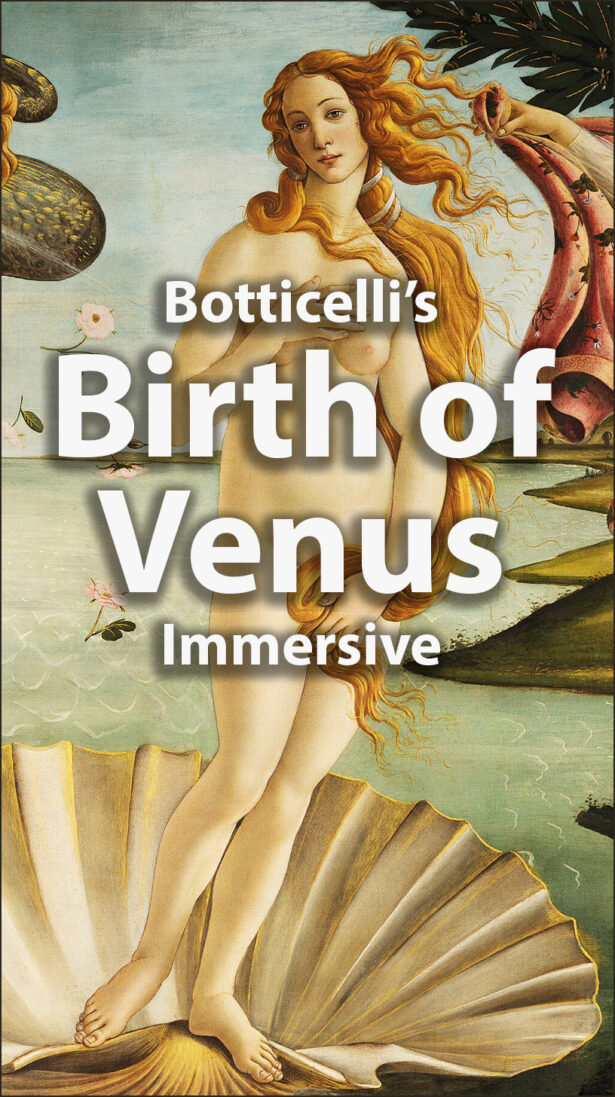A hyper close up study of the details of Botticelli’s Birth of Venus.
Birth of Venus, Sandro Botticelli Firenze 1445 – 1510
This is a three dimensional interpretation on the of one of the most famous and inspiring paintings in the world.
What is it like to see the Birth of Venus in person?
I was able to nudge my way through the crowd to see the details and share the idea of what it feels like to see this painting in person. It took travel across the world, lengthy walks and standing in long lines to get just a few moments of an unobstructed view…but the moment finally came, and there she was, Venus! But seeing a snapshot from a mobile phone while in the gallery is not a good representation of how it feels to see the painting. This is why I make videos more often than I make still image captures.
The lighting in the viewing area is terrible, it’s clinical and bright, not the traditional candles that would have lit this masterpiece over 500 years ago. Each detail takes time to appreciate, the outlines of fingernails, strands of hair gilded in gold, the whispy breaths of the Zephyrs, and so much more.
The immersive video is a concept of dropping in from space, taking a few upclose (very close) moments and then on to the next experience in life.
Where is the Birth of Venus Painting?
Venus can be found in The Uffizi (pronounced oo-feet-z) gallery, which is a massive museum in Florence, Italy. The museum is certainly worth a half day of your vacation travel time. Forget the tour guides unless you like standing in groups while everyone else is free to roam and read the info cards. The most productive way to see the highlights is to buy a ticket ahead of time, and enjoy. You can spend days there, but two to three hours is enough for those on a time crunch.
Details About Botticelli’s Venus
Known as the “Birth of Venus”, the composition actually shows the goddess of love and beauty arriving on land, on the island of Cyprus, born of the sea spray and blown there by the winds, Zephyr and perhaps, Aura. The goddess is standing on a giant scallop shell, as pure and as perfect as a pearl. She is met by a young woman, who is sometimes identified as one of the Graces or as the Hora of spring, and who holds out a cloak covered in flowers. Even the roses, blown in by the wind are a reminder of spring. The subject of the painting, which celebrates Venus as symbol of love and beauty, was perhaps suggested by the poet Agnolo Poliziano.
It is highly probable that the work was commissioned by a member of the Medici family, although there is nothing written about the painting before 1550, when Giorgio Vasari describes it in the Medici’s Villa of Castello, owned by the cadet branch of the Medici family since the mid-15th century. This hypothesis would seem to be born out by the orange trees in the painting, which are considered an emblem of the Medici dynasty, on account of the assonance between the family name and the name of the orange tree, which at the time was ‘mala medica’. Unlike the “Allegory of Spring”, which is painted on wood, the “Birth of Venus” was painted on canvas, a support that was widely used throughout the 15th century for decorative works destined to noble houses.
Botticelli takes his inspiration from classical statues for Venus’ modest pose, as she covers her nakedness with long, blond hair, which has reflections of light from the fact that it has been gilded; even the Winds, the pair flying in one another’s embrace, is based on an ancient work, a gem from the Hellenistic period, owned by Lorenzo the Magnificent. You can see the strands of her hair in the video, painted with incredible precision. From the standing point of view in the Uffizi gallery, these details are harder to see. Another surprise is how the artist presented the fingernails which look normal at a distance, but up close would make a modern women of today cringe with how dirty they appear. Her eyes, are incredibly detailed, and preserve the idea of a glance that is not directed toward the viewer but is about to shift in their direction. Some liberties were taken in the video to add the next second where she might blink, and turn in the viewers direction.
About the Immersive Video
Video footage and editing: by Jef Gray.
Production: The International Peace and Film Festival
Music: Venus Rising performed by Aurous, written by Jef Gray
Song Lyrics:
[Verse 1]
In Florence’s realms, a tale to tell
Of Venus glowing, in a sea-shell.
Ethereal beauty, timeless grace
Her birth unveiled in an artist’s embrace.
Captured in hues,
a masterpiece so divine
[Chorus]
Venus rising from the foam
A symbol of love, she’ll never roam.
Guiding hearts through history’s tome
Embracing souls in an artist’s home
[Verse 2]
From Botticelli’s brush, she emerged.
A vision pure, with love converged
Inspiring poets, painters, and dreamers
In her beauty, we find shimmering streams.
Art’s eternal flame, Venus’ gentle reign.
[Chorus]
Venus rising from the foam
A symbol of love, she’ll never roam
Guiding hearts through histories’ tome
Embracing souls in an artist’s home










